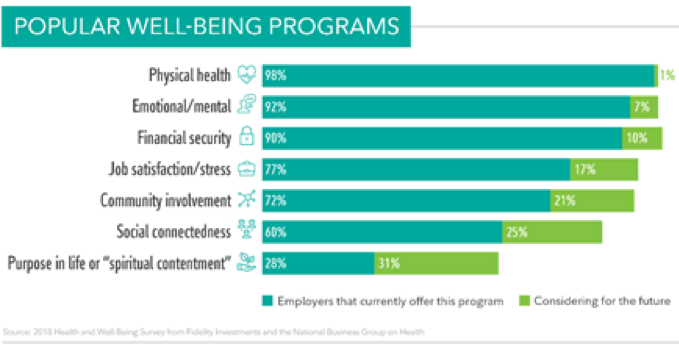The 9th annual Health and Well-being Survey from Fidelity Investments and the National Business Group on Health (NBGH) provides unique insights on corporate wellness trends, especially for those employers looking to remain competitive from a wellness benefits perspective. Most notably, employers are expanding their wellness benefits beyond traditional physical activity programs with more than two-thirds (67%) of companies growing their well-being initiatives over the next three to five years to include programs not specifically focused on physical health. The responses and data from the survey are from 162 jumbo, large, and mid-sized organizations.
Despite the focus beyond physical activity, these types of program remain the most popular amongst employers with 98% currently offering them. Emotional/mental health (92%) and financial security programs (90%) round out the top three, but the most interesting trend is the growth in financial well-being. An additional 19% of employers are considering financial wellness programs for the future, which will soon make this wellness benefit ubiquitous amongst all employers. For those employers who do not currently or plan to offer financial wellness programs, it may be time for them to act to stay competitive. Other examples of increasingly popular non-traditional well-being activities include stress management training (77%), community involvement/volunteerism activities (72%), and social connectedness opportunities (60%).

The survey also suggests that financial incentives continue to play a key role in employee wellness programs. The number of employers offering financial incentives as part of their wellness program increased to 86%, up from 74% in 2017. The average employee incentive amount also increased, growing from $742 in 2017 to $784 in 2018. This growth is part of a longer-term trend with 50% growth from 2013 when the average incentive was $521. The trend is likely to continue with 29% of employers planning on increasing financial incentives as part of their three to five-year strategy.
As employers continue to invest significant resources in their wellness incentives, it is important that they derive the most value possible from the capital, which is why they should adhere to three simple rules for wellness program rewards. These rules, simply put, encourage employers to reward as frequently as possible, offer diverse rewards options, and create tiers within the reward structure. Check out Wellable’s Whiteboard Wednesday session on optimizing employee wellness rewards. Whiteboard Wednesdays are short-form video posts from Wellable on important topics to know for employee health and wellness professionals.
The survey also reviewed how organizations with global workforces deliver wellness programs, if at all, around the world. Forty-four percent of employers offer well-being programs globally, but how they execute on this strategy varied significantly.
- 10% offer a well-being program based on their U.S. strategy
- 34% tailor their offerings for each location
- 42% don’t offer a well-being strategy for employees in other geographies but do provide local regions the ability to implement a program based on their specific needs
Although less than half of employers currently offer wellness initiatives globally, only 10% had no interest in offering one at all. Based on this information, one would expect a trend toward global expansion of wellness programs in future surveys.












